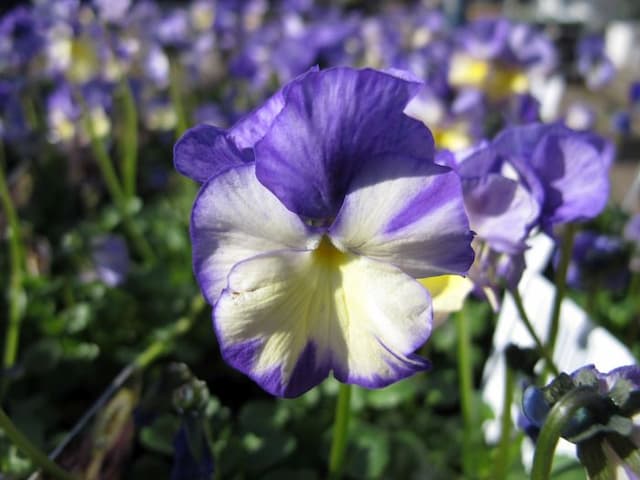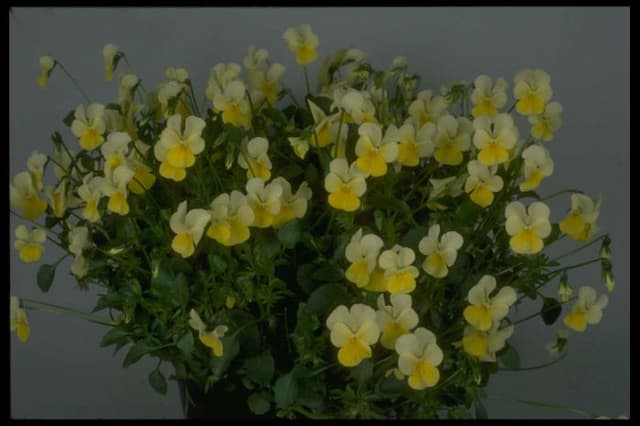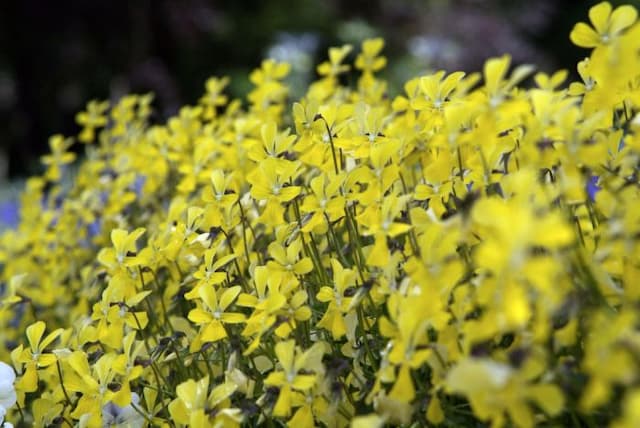Common Blue Violet Viola sororia

ABOUT
The common name for Viola sororia is the common blue violet. It's a perennial plant that typically bears heart-shaped leaves that are broad and somewhat rounded, often with a fine layer of hair-like structures. The leaves grow in a basal arrangement, which means they emerge from the base of the plant on their individual stems. The flower color of the common blue violet usually ranges from blue to violet, though some may present white with streaks of violet. The flowers are delicate, with five petals; the lower petal often has vein-like markings and may have a slight spur at the back. This plant blooms in early spring and often into summer, flaunting its brightly colored flowers that attract various pollinators. After flowering, it produces inconspicuous green seed capsules that can eject seeds when ripe. The overall look of the plant is lush and the flowers have a subtle charm, making it a favorite in wildflower gardens and naturalized areas. The common blue violet is also known for its resilience and ability to spread, forming attractive ground cover in suitable environments.
About this plant
 Names
NamesFamily
Violaceae.
Synonyms
Common Blue Violet, Woolly Blue Violet, Hooded Violet, Florida Violet, Wood Violet, Purple Violet, Sister Violet.
Common names
Viola papilionacea, Viola priceana, Viola sororia var. affinis, Viola sororia var. missouriensis, Viola sororia var. novae-angliae, Viola sororia var. priceana, Viola sororia var. sororia.
 Toxicity
ToxicityTo humans
Common blue violet is generally considered non-toxic to humans. It's often used in salads, syrups, and desserts as an edible flower. However, as with any plant, some individuals may experience an allergic reaction or digestive upset if eaten in large quantities or if they have a sensitivity to it. There is no widespread evidence of significant poisoning or severe consequences from ingesting common blue violet in normal food quantities.
To pets
Common blue violet is also generally considered non-toxic to pets such as dogs and cats. It is not known to cause poisoning in pets, and there are no specific symptoms associated with its ingestion. However, as with any plant matter, if a pet eats large amounts of common blue violet, they could potentially experience digestive upset, such as vomiting or diarrhea, especially if they are not used to eating it. As a precaution, it is always best to monitor your pet's reaction to any new plant.
 Characteristics
CharacteristicsLife cycle
Perennials
Foliage type
Deciduous
Color of leaves
Green
Flower color
Blue
Height
6 inches (15 cm)
Spread
10 inches (25 cm)
Plant type
Herb
Hardiness zones
3
Native area
North America
Benefits
 General Benefits
General Benefits- Aesthetic Appeal: Viola sororia, commonly known as the common blue violet, adds beauty to gardens with its delicate blue-violet flowers and heart-shaped leaves.
- Wildlife Attraction: The flowers provide nectar for butterflies and other pollinators, while the leaves serve as a food source for caterpillars of certain butterfly species.
- Ground Cover: This plant can serve as an effective ground cover due to its spreading habit, helping to prevent soil erosion and suppress weeds.
- Low Maintenance: The common blue violet is known for being hardy and requiring minimal care once established, making it a practical choice for gardeners of all skill levels.
- Shade Tolerance: It thrives in shaded areas where other flowers might struggle to grow, making it ideal for woodland gardens or shaded borders.
- Eco-friendly Landscaping: As a native North American species, it supports local ecosystems and biodiversity when planted within its native range.
 Medical Properties
Medical Properties- Expectorant: Viola sororia has traditionally been used to help expel mucus from the throat and lungs.
- Diuretic: The plant has been used to promote the excretion of urine, which can be helpful in conditions like urinary tract infections.
- Anti-inflammatory: Some compounds in Viola sororia may have anti-inflammatory properties, potentially useful in addressing inflammation-related conditions.
 Air-purifying Qualities
Air-purifying QualitiesThis plant is not specifically known for air purifying qualities.
 Other Uses
Other Uses- Natural dye: Viola sororia can be used to produce a greenish-yellow dye that is often used to color clothes or craft items.
- Ecosystem service: As a native plant, it provides a vital role in supporting local ecosystems, offering food and habitat for insects like butterflies and bees.
- Garden aesthetics: Known for its beauty, gardeners sometimes use Viola sororia to create stunning naturalized drifts in shady garden areas.
- Edible flowers: The blooms of Viola sororia are edible and can be used to garnish salads, desserts, or drinks for a touch of color and mild flavor.
- Teaching tool: Due to its interesting reproductive strategy, Viola sororia can be used in educational settings to teach botany and plant biology.
- Ice cubes: Frozen viola sororia flowers in ice cubes can make a visually intriguing addition to beverages at special events.
- Companion planting: Some gardeners use Viola sororia as a companion plant to help bring beneficial insects to the garden which can aid in the pollination of vegetables and fruit plants.
- Craft projects: The pressed flowers of Viola sororia can be used in craft projects like making bookmarks, greeting cards, or framed botanical art.
- Mood setting: Due to their pleasant appearance, Viola sororia flowers are sometimes used in spas or retreat centers to create a tranquil ambiance.
- Floral arrangements: Its flowers can be used in small floral arrangements, particularly for events in the spring when Viola sororia is in bloom.
Interesting Facts
 Feng Shui
Feng ShuiThe Common Blue Violet is not used in Feng Shui practice.
 Zodiac Sign Compitability
Zodiac Sign CompitabilityThe Common Blue Violet is not used in astrology practice.
 Plant Symbolism
Plant Symbolism- Innocence: The delicate and modest appearance of the common violet, Viola sororia, often symbolizes innocence and purity.
- Humble love: This flower is frequently associated with understated affection, offering a symbol for love that is deep yet not ostentatious.
- Spiritual wisdom: Violets are sometimes connected to spiritual enlightenment and wisdom, potentially due to their subdued presence in the shade of other plants.
- Modesty: The way violets tend to hide their flowers beneath their leaves has historically been interpreted as a symbol of humility and modesty.
- Faithfulness: In the Victorian language of flowers, the common violet represents faithfulness, loyalty, and steadfastness in love.
 Water
WaterThe common blue violet, Viola sororia, prefers consistently moist soil and should not be allowed to dry out completely. It is generally recommended to water the plant once a week, providing it with about 1 inch of water at each watering session. The actual frequency can vary depending on climate conditions and soil type; in hotter, dryer periods, it might require watering twice a week. It's best to water the plant deeply rather than a light sprinkle, to encourage deep root growth. Use room temperature water to avoid shocking the plant's roots.
 Light
LightCommon blue violets thrive in partially shaded conditions; they do well under dappled sunlight or in an area that receives morning sun and afternoon shade. Avoid placing them in full sun, which can be too intense and may scorch the foliage. A north-facing or east-facing spot that gets filtered light is ideal for promoting the best growth and flowering.
 Temperature
TemperatureCommon blue violets are hardy and able to withstand a temperature range from as low as 20°F to around 85°F. They prefer cooler conditions and perform best when temperatures are between 60°F and 75°F. Prolonged exposure to temperatures outside of this range, especially extreme heat, can stress the plant and impact its health and blooming.
 Pruning
PruningPruning common blue violets is typically done to remove dead or yellowing leaves and to maintain a tidy appearance. Light pruning can be performed at any time during the growing season to remove spent flowers and encourage bushier growth. Intensive pruning should be done in late fall or early spring to prepare the plant for new growth.
 Cleaning
CleaningAs needed
 Soil
SoilThe Common Blue Violet (Viola sororia) thrives best in a soil mix that is rich, moist, and well-draining. A good recipe for soil mix would be a blend of loamy garden soil, peat moss, and compost, which helps ensure both moisture retention and proper drainage. The ideal soil pH for the Common Blue Violet should be slightly acidic to neutral, ranging from 6.0 to 7.0.
 Repotting
RepottingThe Common Blue Violet typically does not need to be repotted often as it's a perennial that can spread through self-seeding. However, if grown in a container, it may benefit from repotting every 2-3 years to refresh the soil and accommodate growth.
 Humidity & Misting
Humidity & MistingThe Common Blue Violet prefers a moderate humidity level but is quite adaptable to different humidity conditions as it is a native woodland plant. It is tolerant of the average humidity found in most homes and gardens.
 Suitable locations
Suitable locationsIndoor
Provide bright, indirect light and keep soil moist for indoor Common Blue Violets.
Outdoor
Plant in partial shade with rich, moist soil for outdoor Common Blue Violets.
Hardiness zone
3-9 USDA
 Life cycle
Life cycleViola sororia, commonly known as the "Common Blue Violet," begins its life cycle as a seed, typically germinating in the cool, moist conditions of late winter to early spring. Upon germination, the plant develops a root system and a rosette of heart-shaped leaves close to the ground. As the plant matures, it sends up stems bearing the distinctive purple flowers in the spring; these flowers can self-pollinate or be cross-pollinated by insects. After pollination, the flowers produce fruits that are technically capsules containing seeds, which are dispersed by various means, such as water, animals, or mechanical forces. In addition to sexual reproduction, Viola sororia can propagate vegetatively through stolons, allowing for clonal colonies to form. The plant enters a period of dormancy during the colder months, but it is a perennial and will re-emerge from the rootstock with the arrival of favorable growing conditions in the next season.
 Propogation
PropogationPropogation time
Spring to summer
The common blue violet, Viola sororia, is often propagated by seed, as it's the most popular method. Seeds can be collected from mature plants after flowering and seed capsule formation, usually in late spring to early summer. Seeds should be spread on the surface of a well-drained seed starting mix and lightly pressed into the soil. They require darkness to germinate, so it is crucial to cover them with a thin layer of soil or fine sphagnum moss. Ideal germination temperatures are between 65 and 70 degrees Fahrenheit (18-21 degrees Celsius). Seedlings usually emerge in two to four weeks, after which they should be gradually acclimated to outdoor conditions before being transplanted to their final location in the garden. Care must be taken to keep the soil consistently moist but not waterlogged during germination and early growth.









